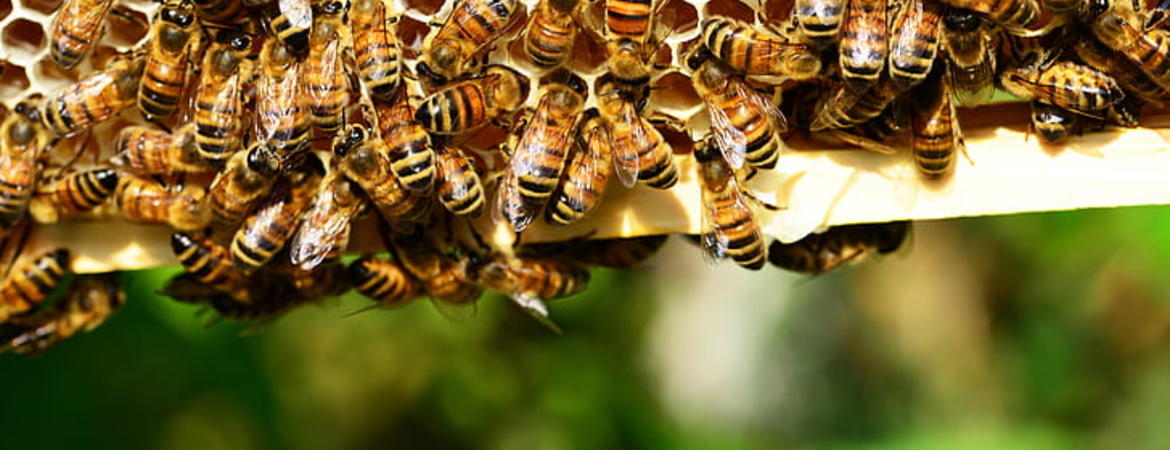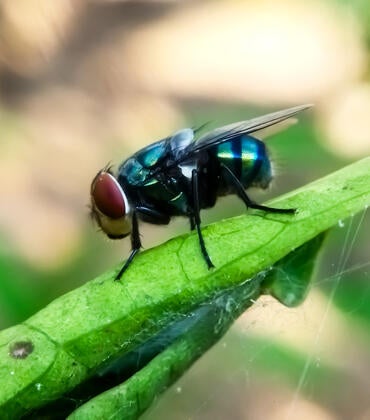
World Bee Day is May 20. To mark the occasion, we gathered some of UC Riverside’s top bee experts to answer questions submitted on our Instagram page. The response created, for lack of a better term, quite a buzz!
We got so many questions — hundreds — that we could not answer them all on social media. For those interested in lengthier answers to some of the questions, we’ve posted many of them here, organized by topic.
Entomology
How closely are bees and wasps related to one another?
Technically speaking, bees are wasps that have evolved to feed on pollen. The ancestor of all modern bees was, as far as we can tell, a very small wasp that fed on a type of insect called thrips, and many thrips eat pollen. At some point over 100 million years ago, descendants of this wasp shifted to feeding on pollen directly, and over many generations they became bigger and hairier, and eventually were able to gather pollen and feed it to their larvae. We know of at least two "transitional" fossils that bridge this gap between wasps and bees, both of them 100 million years old, called Discoscapa and Melittosphex. It's also worth knowing that ants are, technically, also wasps, but a type of wasp that evolved a sterile, wingless form of offspring (the "worker caste") that allows them to form large colonial societies.
- Doug Yanega, UCR Entomology Research Museum senior scientist
How many species of bees exist and which is the most aggressive toward humans?
There are over 20,000 species of bees in the world today; we discover many previously unknown species every year, but at the same time, a number of species go extinct, so we can never be certain of the exact number. No bee species are aggressive toward humans, but there are a small number, including honeybees, that have defensive behaviors, and they will attack almost anything that threatens their nests including bears, skunks, badgers, raccoons, birds, and humans. Of all the bees, the defensive responses of honeybees are the most dramatic, and the most life-threatening, so people who work with honeybees need to wear special protective gear. (DY)
Conservation
How can we help support our local honeybees and keep them from going extinct?
First, this depends on where you live. If you live in the U.S. or Canada or Mexico, for example, honeybees are not native here, and the only place they should be is in managed colonies under a beekeeper's care. They're a domesticated animal used in agriculture, like chickens, cows, pigs, and sheep, and they really should never be allowed loose into the wild, because they can have negative effects on native ecosystems, like any exotic species. When used to pollinate crops, they serve an important function, but outside of that specific context, they aren't actually good to have around; they consume food that could have been used by native bees and other pollinators, and they help spread invasive weeds that native pollinators aren't pollinating. So, in the long run, you don't actually want to have any local honeybees other than the ones being kept by beekeepers. If you live in Europe, where honeybees are native, then keeping your local honeybees healthy means protecting habitat first, and working to reduce pesticide use outside of very limited amounts of farmland.
The second part of the question relates to the likelihood of extinction. The honeybee — specifically, the species Apis mellifera — is the least threatened bee species in the world, and the global population is higher now than it has ever been in human history. Beekeepers are raising honeybees much, much faster than they are dying, so their population is constantly increasing. There is no possibility, as things stand, that this species will ever go extinct, under any circumstances, unless the entire global ecosphere collapses and *everything* goes extinct.
There are, on the other hand, a lot of other bee species in the world — over 20,000 more species, in fact — and many of those bees are threatened with extinction, and several have already gone extinct within the last few decades. Those other bee species need safe places to live and thrive, so the preservation and protection of wild, native habitats is the thing that is most essential to their survival. (DY)
What plants I can add to my garden to attract bees and provide a home for them?
There are a lot of resources to help us select the best plants for our garden to attract a diversity of insect and hummingbird pollinators. Pollinators are looking for nectar and pollen rewards, and luckily a lot of plant species do well in garden environments. You will want to check out lists that are for your area and climate.
For California, for example, good resources include Xerces Society’s Pollinator Plants.The Pollinator Partnership also has a nice site that allows you to input your ZIP code and get a list of potential pollinator plants that will thrive in your area.
- Erin Rankin, associate professor of entomology
Also, lawns provide no resources for bees. Consider using the Riverside public utility rebate to remove your lawn and replace it with native plants to support pollinators?
- Lauren Ponisio, assistant professor of entomology
Honey
Why do bees make honey?
Honeybee colonies live for years — unlike the vast majority of the 20,000 some other bee species. To get through the times of year when there are few or no flowers out, they store nectar as honey. Very few other types of bees (bumblebees and stingless honeybees) will also store honey, but it’s very different in consistency, and much closer to raw nectar.
- Quinn McFrederick, associate professor of entomology
Is it true that buying and consuming honey is bad for bees?
Honeybees have been domesticated for thousands of years, and we humans used artificial selection to increase the amount of honey they store — just like we selected cows for milk production or chickens for larger muscles that we can eat. Honeybees have been moved all over the world due to this domestication, so they have also benefitted. Beekeepers either leave the bees enough honey stores to get through winter or feed them, so their colonies persist. Some bees are lost through management, but a good beekeeper always makes sure their bees flourish. (QM)
What medicinal value has honey been proven to possess?
Manuka honey (from a tree in New Zealand) commands a huge price tag because of its antimicrobial properties, and honey has lots of plant chemicals that are good for us. But it is very carbohydrate rich, so you can get too much of a good thing. (QM)
How much is most store-bought honey from bees?
Unscrupulous suppliers can adulterate honey with corn syrup, but the USDA has developed guidelines to detect adulterated honey. Buying from local beekeepers is always a good strategy to be sure your honey is pure and to support your local economy. (QM)
Just for fun
What’s your favorite bee?
Andrena cleodora: an elegant California native bee, mostly black and gold. If I ever reproduce, I will name my firstborn child Andrena. (LP)
Do bees have knees?
Bees have jointed legs with several segments. However, they do have a joint between their femur and tibia. This joint would be the most like a knee. Many bees have a small plate in this position, called the “basitibial plate,” and it could be considered their equivalent of a “kneecap.” (ER)



